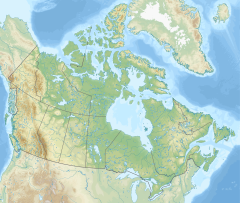| Wood Buffalo National Park | |
|---|---|
 Grosbeak Lake | |
| Location | Alberta and Northwest Territories, Canada |
| Nearest city | Fort Chipewyan Fort Smith |
| Coordinates | 59°23′N 112°59′W / 59.383°N 112.983°W |
| Area | 44,741 km2 (17,275 sq mi) |
| Established | 1922 |
| Visitors | 2399 (in 2022–23[2]) |
| Governing body | Parks Canada |
| Website | pc |
| Criteria | Natural: vii, ix, x |
| Reference | 256 |
| Inscription | 1983 (7th Session) |
Wood Buffalo National Park is the largest national park of Canada at 44,741 km2 (17,275 sq mi).[3] It is in northeastern Alberta and the southern Northwest Territories. Larger in area than Switzerland,[4] it is the second-largest national park in the world.[5] The park was established in 1922 to protect the world's largest herd of free-roaming[6] wood bison. They became hybridized after the introduction of plains bison. The population is currently estimated at 3,000.[7][8] It is one of two known nesting sites of whooping cranes.
The park ranges in elevation from 183 m (600 ft) at the Little Buffalo River to 945 m (3,100 ft) in the Caribou Mountains. The park headquarters is in Fort Smith, with a smaller satellite office in Fort Chipewyan, Alberta. The park contains one of the world's largest fresh-water deltas, the Peace-Athabasca Delta, formed by the Peace, Athabasca and Birch rivers.
It is also known for its karst sinkholes in the north-eastern section of the park. Alberta's largest springs (by volume, with an estimated discharge rate of eight cubic metres per second), Neon Lake Springs, are in the Jackfish River drainage.[9] Wood Buffalo is located directly north of the Athabasca Oil Sands.
This area was designated in 1983 as a UNESCO World Heritage Site for the biological diversity of the Peace-Athabasca Delta, and for the population of wild bison. It is the most ecologically complete and largest example of the Great Plains-Boreal grassland ecosystem of North America.[10]
On June 28, 2013, the Royal Astronomical Society of Canada designated Wood Buffalo National Park as Canada's newest and the world's largest dark-sky preserve. The designation helps preserve nighttime ecology for the park's large populations of bats, night hawks and owls, as well as providing opportunities for visitors to experience the northern lights.[11]
- ^ "Protected Planet | Wood Buffalo National Park Of Canada". Protected Planet. Retrieved 2020-10-13.
- ^ Canada, Parks. "Parks Canada attendance 2022_23 - Parks Canada attendance 2022_23 - Open Government Portal". open.canada.ca. Retrieved 2024-05-07.
- ^ Parks Canada Agency, Government of Canada (2022-11-15). "Stewardship and management - Stewardship and management". parks.canada.ca. Retrieved 2023-03-11.
- ^ "World's largest beaver dam". Parks Canada–Wood Buffalo National Park. Archived from the original on 9 February 2016. Retrieved 12 January 2016.
- ^ Johnston, Karl. "Heaven Below Me – Exploring Wood Buffalo National Park from the Air". Let's Be Wild. Archived from the original on 2 April 2015. Retrieved 16 November 2012.
- ^ Natural World Heritage Site
- ^ "Ottawa produces action plan for Wood Buffalo National Park" – via The Globe and Mail.
- ^ "Wood Bison". Parks Canada. April 27, 2020. Archived from the original on September 16, 2022. Retrieved July 12, 2021.
- ^ Rollins, John (2004). Caves Of The Canadian Rockies And Columbia Mountains. Surrey, Canada: Rocky Mountain Books. ISBN 978-0-92110-294-6. Retrieved 25 May 2015.
- ^ "Wood Buffalo National Park: Statement of Significance". UNESCO World Heritage Centre. Retrieved 18 December 2014.
- ^ Thompson, Deborah (2 August 2013). "RASC Designates Wood Buffalo National Park as a New Dark Sky Preserve" (Press release). Toronto, Canada. Retrieved 3 August 2013.

